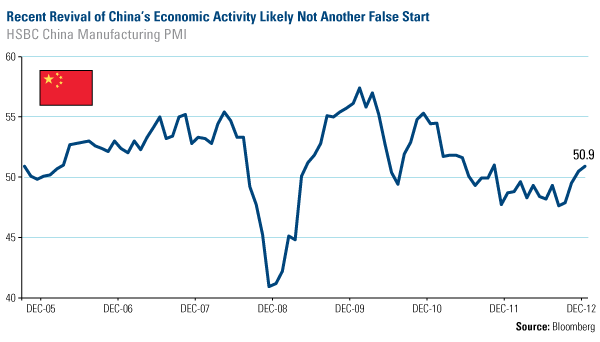Emerging Markets Radar (December 17, 2012)
Strengths
- China reported economic data for November. Retail sales were up 13.6 percent from 13.5 percent and industrial production was up 10.1 percent from 9.6 percent in October. Electricity production was 7.9 percent, up from 6.4 percent a month earlier. CPI inflation ticked up to 2.0 percent, lower than the estimate.
- The HSBC China Flash PMI was 50.9 in December versus the estimated 50.8. It was 50.5 in November. PMI above 50 indicates industrial activities are expanding. The number confirms a continued recovery in China primarily due to domestic fiscal spending in infrastructure and construction.
- China’s November fixed asset investment growth stayed stable at 20.7 percent in the January-November period, due to slower growth in railway equipment and flat growth in manufacturing investments, but faster growth in property and railway infrastructure investments.
- After five months of year-over-year declines, China’s monthly railway freight transport turnover turned into growth at 2.4 percent in November. Monthly passenger turnover growth accelerated to 6.5 percent in November from 2.1 percent in October as more new lines started operations.
- China’s passenger vehicle wholesale was up 10.3 percent in November from 5.9 percent in October, while retail sales were up 8.75 percent. In particular, SUV sales were up 18.02 percent year-over-year. BMW sales were up 62 percent year-to-date.
- China’s system-wide credit growth edged up further in November to 20.2 percent from 20.1 percent in October. Such robust credit growth lends support to GDP growth.
- The China Securities Regulatory Commission has halted IPO approvals for two months, and will probably extend the ban until at least February 2013 as it tries to underpin the market, the South China Morning Post reported. The Shanghai Composite Index was up 4.32 percent on Friday, successfully breaking out from its 150-day moving average.
Weaknesses
- China’s November exports were up 2.9 percent, lower than the market consensus of 9 percent.
- China’s M2 money supply growth slowed to 13.9 percent in November from 14.1 percent in October. New bank loans rose to RMB 523 billion from RMB 505 billion in October. Industry analysts think the lower M2 growth rate and new bank loans were due to increasing issuance of corporate bonds, which cost less than bank loans.
- Hong Kong’s basic power tariff hike was less than 1 percent, lower than the market’s expectation of 2 percent.
- The Bank of Korea left its policy rate unchanged at 2.75 percent after two 25-basis point cuts in July and October. Economic growth momentum remains weak going into the fourth quarter of the year, but investors are expecting a modest growth recovery in the coming quarters.
Opportunities

- The chart above shows HSBC China flash PMI is 50.9 after rising for four months. The upbeat flash manufacturing PMI suggests China’s recovery is continuing in the last few weeks of 2012. Although new export orders fell below 50, and, for that matter, the inventories index rose from 48.8 to 49.7, we expect the recovery to continue in the first half of 2013 due to continued domestic fiscal spending on infrastructure and urbanization. Investors will watch this weekend’s China Central Economic Working Conference for clues of policy directions.
- Shanghai is encouraging couples who are both single children to have a second baby, the Xinhua News Agency reported this week, citing the municipality’s population and family planning committee. There are also talks that China will abandon the one-child policy soon, which will allow a balanced demographic age mix and support economic growth.
- November inflation in Russia was at 0.3 percent, half the expected number, paving the way for the central bank to reverse monetary policy to ease and to relieve funding pressure on the banks.
Threats
- The Bank of Indonesia kept the benchmark interest rate unchanged at 5.75 percent this week. With increasing current account deficits, the market expects the central bank to tighten monetary policy next year.
- China’s disappointing November export growth indicates China still faces challenging external markets, which is a drag on economic growth. New export orders in the HSBC December China flash PMI also showed a contraction to 49.3 from 52.1 in November.
- New power generation capacity will put pressure on non-regulated power prices, affecting profitability of power generation companies in Russia, where demand growth for power is flat to negative.












